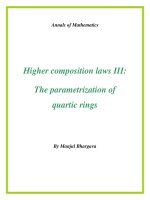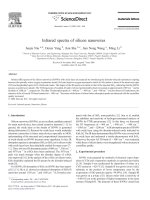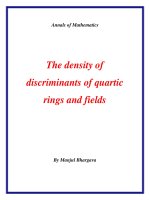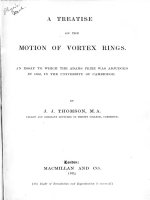Infrared spectra of aromatic rings
Bạn đang xem bản rút gọn của tài liệu. Xem và tải ngay bản đầy đủ của tài liệu tại đây (1.83 MB, 18 trang )
Infrared spectra of aromatic rings
Aromatic IR spectra are messy and difficult. They show many small bands of no diagnostic value, but
some are useful.
While Aromatic and Alkene C-H stretches both occur just over 3000, the C=C aromatic stretches appear
between 1600 and 1450, outside the usual range for alkenes which is near 1650. Aromatic C=C stretches
are often in pairs, with one at 1600 and one at 1475.
Like substituted alkenes, there are out-of-plane C-H bends between 900 and 690. These result in an
overtone/combination band between 2000 and 1667, which is often used to assign how the aromatic
molecule is substituted. I assume this because the overtone/combination region is less likely to be
obscured by other peaks.
The shaded boxes in the table above actually correspond to out-of-plane C=C bends.
Below are some spectrum examples:
Infrared spectrum of toluene
Infrared spectrum of ortho-diethylbenzene
Infrared spectrum of meta-diethlbenzene
Infrared spectrum of ortho-diethylbenzene
Infrared spectrum of para-diethylbenzene
Infrared spectrum of styrene
The in-plane bending occurs between 1000 - 1300, but these bands are not useful since they overlap with
stronger bands in this region.
The original C-H out-of-plane bands can also be used to assign substitution directly in some cases, rather
then using the overtone/combination region. It is suggested to use the the 900 - 690 region only for certain
substituents:
Reliable substituents:
Alkyl-Alkoxy-Halo-Amino-Carbonyl-
Unreliable:
Nitro-Carboxylic acid and derivatives Sulfonic acids and derivatives
Monosubstituted: Always gives a strong band at 690, but in a halocarbon solvent this may be obscured by
a C-X stretch. A second strong band usually appears at 750.
Orthosubstituted: One strong band near 750.
Metasubstituted: One band near 690 and one near 780. A third band is often found at 880.
Parasubstituted: One strong band between 800 and 850.
Ester infrared spectra Vinyl acetate
Methyl benzoate
Methyl methacrylate
Methyl salicylate
Ethly butyrate
The C=O of an ester appears near 1750-1735 which can overlap with some ketone C=O stretches. One
can usually eliminate ketones by considering the strong and broad C-O peak at 1300-1000. A ketones
absorptions will have a weaker and narrower bands. Compare the ethyl butyrate ester above to the ketone
below:
Esters can also conjugate on the side of the single-bonded oxygen:
Apparently this form of conjugation interferes with resonance of the carbonyl group, hence increasing the
arbsorption frequency of the C=O bond.
α-keto esters: One might expect two C=O peaks due to the two different carbonyls. In practice, it usually
manifests as a shoulder on the main C=O peak or a single broadened band.
β-keto esters: These give a strong intensity doublet for the C=O stretches. Since they do not tautomerize
to the same extent as β-diketones, one cannot generally observe the OH stretch from the enol form.
Infrared spectra of alcohols and phenols
O-H stretch: The free O-H stretch is a small sharp peak at 3650-3600.
The hydrogen-bonded O-H stretch is a broad strong peak at 3400-3300.
For the neat liquid, all the alcohol is considered hydrogen bonding, so the broad peak is the only one of
the two visible. As the alcohol is dissolved in a non-hydrogen bonding solvent, the free O-H peak
becomes more visible:
The right-side picture is of an extremely diluted alcohol, or a gas.
C-O-H bend: Broad weak peak at 1440-1220, often obscured by CH3 bends.
C-O: Stretch occurs at 1260-1000
1-Hexanol:
2-Butanol:
Para-cresol:
The free O-H stretch occurs near 3640, 3630, 3620, 3610 for primary, secondary, tertiary, and phenolic
alcohols respectively. But resolving frequency differences this small requires careful calibration, so these
distinctions are of no use.
Intramolecular hydrogen bonding usually shifts the O-H stretch to a lower frequency. For example, for
methyl silicate it is situated about 3200, around 150 less then the average phenol.
The strong C-O stretch at 1260-1000 can be used to determine the structure of the alcohol, notably more
easy than with the O-H stretch:
Carboxylic acid infrared spectra
The obvious way to recognize an acid is by noting both a OH and a C=O stretch. The C=O stretch for the
monomer is at 1760-1730, but carboxylic acids form dimers even in dilute solutions, the dimer C=O
stretch is at 1730-1700. As usual for carbonyls, conjugation lowers it and a halogen on the α-carbon
increases it.
The C-O stretch for an acid is near 1260.
O-H out-of-plane bending produces a broad, medium-weak band around 930.
Isobutyric acid
Benzoic acid
Aldehyde infrared spectra
The normal C=O stretch for aldehydes is 1725, since for ketones the normal stretch is 1715, it is difficult
to distinguish the two using a C=O stretch.
To distinguish aldehydes from other carbonyl-containing compounds, look for the doublet in the C-H
region, near 2850 and 2750. The 2750 is more useful, because the 2850 can overlap with other C-H
stretches.
Nonanal. The peak at 1460 is due to bending of CH2. Methylene groups often absorb stronger when
attached to a cabonyl.
Crotoaldehyde
Benzaldehyde
The reason the C-H splits into two peaks is due to fermi-resonance, from a coupling of the C-H stretch
with the first overtone of the aldehyde C-H bend at 1400-1350.
Amide infrared spectra
Amides show a very strong C=O peak at 1680-1630.
Primary amines give two N-H stretch peaks, one near 3350 and one near 3180, from asymmetric and
symmetric vibrations respectively.
Secondary amines give one N-H stretch peak at 3300
N-H bending at 1640-1550 for both secondary and primary amides.
N-methyl acetamide
Note how the C=O partially overlaps the N-H bend.
For dilute solutions the C=O is found at 1690. This is for the same reason as carboxylic acids - hydrogen
bonding normally lowers the C=O frequency.
Like other carbonyl compounds, the C=O stretch frequency increases with decreasing ring size, by about
40 per carbon removed.
Ether Infrared spectra
The obvious way to know a molecule is an ether is to see a C-O peak, but no C=O or O-H, since the
absence of a C=O or O-H stretch confirms it is not an ester, acid, or alcohol.
The C-O stretch is found between 1000 and 1300.
Aliphalic ethers give one strong asymmetric stretch around 1120, and a very weak symmetric stretch
around 850.
Aryl alkyl ethers give two bands around 1250 and 1040, symmetric and asymmetric respectively.
An example of each is below:
Dibutyl ether
Anisole c6h5och3
Vinyl ethers: These give a strong asymmetric stretch near 1220, and a very weak symmetric stretch near
850.
The increase in asymmetric stretch frequency of vinyl and aryl ethers compared to alkyl ethers can be
explained by resonance:
Amine infrared spectra
Butylamine
Dibutylamine
Tributylamine
N-methylaniline
N-H stretch: At 3500-3300. This is split into two bands for a primary, one for a secondary, and is
nonexistent for a tertiary amine. The intensity can be small for aliphatics, often vanishingly small for
secondary aliphatic amines. For aromatics the stretch can be quite large.
The higher frequency band is from a symmetric vibration, the lower from asymmetric vibration.
In dilute solutions (non hydrogen-bonded) the peaks are shifted higher.
N-H in-plane-bend: A broad peak at 1640-1560 for primary amines. Secondary amines absorb near 1500.
Can overlap a C=C peak.
N-H oop bend: Sometimes observed near 800, seen more easily in aliphatic amines.
C-N stretch: Occurs at 1350-1000, varying intensity. 1250-1000 for aliphatics, 1350-1250 for aromatics.
The higher frequency in aromatics is from resonance increasing double-bond character between the ring
and attached nitrogen.
For a neat liquid, the N-H peak is typically weaker and sharper than O-H:
Ketone infrared spectra
In addition to the obvious C=O stretch, ketones also have a C-CO-C bend:
Aromatic ketones have this stretch at the higher end, aliphatic ketones have this stretch at the lower end.
Methylene and methyl groups next to the carbonyl tend to absorb with greater intensity than usual.
The 1715 C=O stretch produces a very weak overtone band at 3430. Avoid confusing it with O-H
absorptions, which are much more intense.
The ketene above can be considered an extreme example of a strained ring. S character of the double
bond increases with ring strain, and this reaches a maximum when attached to a sp-hybridized carbon in a
ketene.
1,2-diketones, also called α-ketones, have one strong absorption about 1716. As expected with normal
carbonyls, this peak is lower when the diketone is conjugated. Diketones may also produce a narrowly-
spaced doublet due to the asymmetric and symmetric absorptions (eg. the carbonyls might stretch
together, or one might stretch while the other contracts).
1,3-diketones, also called β-ketones, show more complicated patterns due to tautomerization to the enol
form:
The enol form is particularly stable for diketones due to the hydrogen bond, so spectra often show both
C=O peaks.
The shifted C=O stretch in the enol can be explained by the hydrogen bond, and by resonance:
The relative intensities of the two types of C=O can provide a method for seeing which form is more
prevalent.
Ketone examples:
Cyclopentanone
Mesityl oxide
Acetophenone
Cyclopentanone
Ketals and acetals infrared spectra
Ketal
Acetal
Ketals give four strong bands at 1200-1020
Acetals give five strong bands at 1200-1020
C=C stretching vibrations
The C=C stretch vibration appears between 1670 and 1640. Frequency increases as substituents are added to the double
bond.
Monosubstituted ones are about 1640
Disubstituted about 1650
Tri and tetra absorb around 1670
Trans substituents absorb about 10 higher than cis.
The C=C is typically a weak absorption. It may be completely obscured by a shifted C=O stretch. It won't absorb at all if the
attached groups are symmetric. Cis alkenes have less symmetry than trans, so will have a more intense absorption, despite
being at a lower frequency.
Rings and terminal alkenes typically have high and low symmetry respectively, so we would expect terminal alkenes to have
a higher absorption than cyclic alkenes.
Conjugation with another C=C or a C=O will increase single bond character, decreasing the frequency.
Conjugated systems often have two closely spaced peaks, resulting from possible conformations.
C-H bending region









